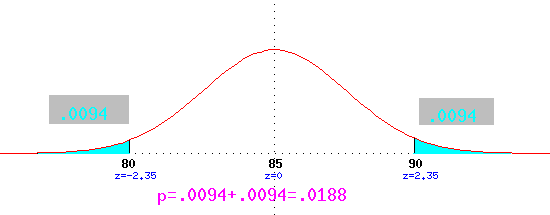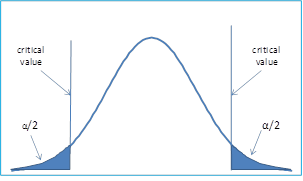

- #Two sample two tailed hypothesis test calculator how to#
- #Two sample two tailed hypothesis test calculator free#
The f-test statistic for testing above $H_0:\sigma^2_1=\sigma^2_2$ is $F =\frac$ the null hypothesis. In this tutorial we will calculate f-test two-sample for variances calculator and six steps approach used in hypothesis testing to test whether two population variances are same or not. We perform a two-tailed Z-test if we want to test whether the population mean is not : H:, and a one-tailed Z-test if we want to test whether the. The null hypothesis is that the population mean value is equal to a given number, : H. p0.1676749174: This is the p-value that corresponds to the test statistic. t-1.42825817: This is the t test statistic.
#Two sample two tailed hypothesis test calculator how to#
Since we assume that the actual population mean is 15.1, we can compute the lower tail probabilities of both end points. Our calculator will automatically produce the results of the two sample t-test: Here is how to interpret the results: 12: This is the alternative hypothesis for the test. F test is used to compare two population variances or population standard deviations. A one sample Z-test is one of the most popular location tests. Therefore, so long as the sample mean is between 14.572 and 16.228 in a hypothesis test, the null hypothesis will not be rejected.

We can tell what specific value x of the random variable X takes only after performing the experiment.Many times it is desirable to compare two variances rather than comparing two means.The domain of the random variable (RV) is not necessarily a numerical set the domain may be expressed in words for example, if X = hair color, then the domain is.Variables in statistics differ from variables in intermediate algebra in two following ways.

For example, if X is the number of children in a family, then x represents a specific integer 0, 1, 2, 3, …. Common notation for variables are upper-case Latin letters X, Y, Z,… Common notation for a specific value from the domain (set of all possible values of a variable) are lower-case Latin letters x, y, z,…. Variable (Random Variable) a characteristic of interest in a population being studied. Standard Deviation A number that is equal to the square root of the variance and measures how far data values are from their mean notation: s for sample standard deviation and σ for population standard deviation.

#Two sample two tailed hypothesis test calculator free#
Glossary Degrees of Freedom ( df) the number of objects in a sample that are free to vary. There is sufficient evidence to conclude that there is a significant difference between the means of the statistics day students and night students on Exam 2.For a one-sided test at significance level (alpha), look under the value of 2(alpha) in column 1. Note that in Excel 2007 we calculate p-value TDIST(t, df, 2) TDIST(3.66, 39, 2). Table showing minimum sample sizes for a two-sided test: The table below gives sample sizes for a two-sided test of hypothesis that the mean is a given value, with the shift to be detected a multiple of the standard deviation. There is insufficient evidence to conclude that there is a significant difference between the means of the statistics day students and night students on Exam 2. Since tobs 3.66 > 2.02 once again we reject the null hypothesis.There is insufficient evidence to conclude that the statistics day students’ mean on Exam 2 is better than the statistics night students’ mean on Exam 2.There is sufficient evidence to conclude that statistics night students’ mean on Exam 2 is better than the statistics day students’ mean on Exam 2.The “night” subscript refers to the statistics night students. The “day” subscript refers to the statistics day students. The mean and standard deviation for 37 statistics night students were 75.41 and 19.73. The mean and standard deviation for 35 statistics day students were 75.86 and 16.91. She takes random samples from each of the populations. Suppose a statistics instructor believes that there is no significant difference between the mean class scores of statistics day students on Exam 2 and statistics night students on Exam 2. Cohen’s Standard Effect Sizes Size of effectĬohen’s d is the measure of the difference between two means divided by the pooled standard deviation: where The calculated value of effect size is then compared to Cohen’s standards of small, medium, and large effect sizes. Cohen’s d, named for United States statistician Jacob Cohen, measures the relative strength of the differences between the means of two populations based on sample data. The evidence shows that the mean of the final exam scores for the online class is lower than that of the face-to-face class.Īt the 5% level of significance, from the sample data, there is (is/is not) sufficient evidence to conclude that the mean of the final exam scores for the online class is less than the mean of final exam scores of the face-to-face class.Ĭohen’s Standards for Small, Medium, and Large Effect Sizes Cohen’s d is a measure of effect size based on the differences between two means.


 0 kommentar(er)
0 kommentar(er)
